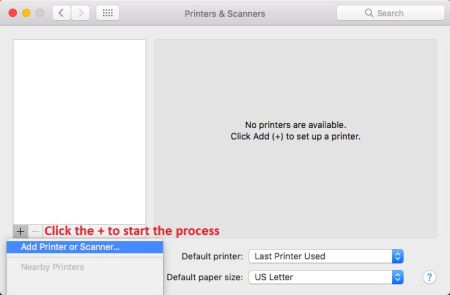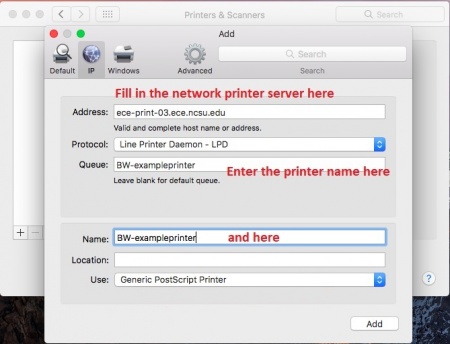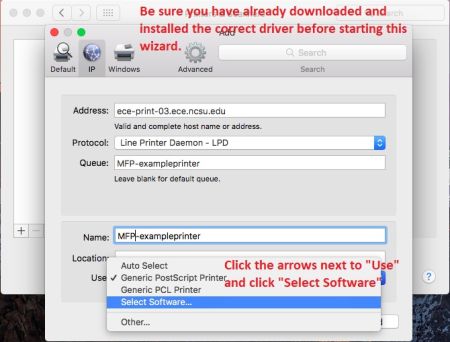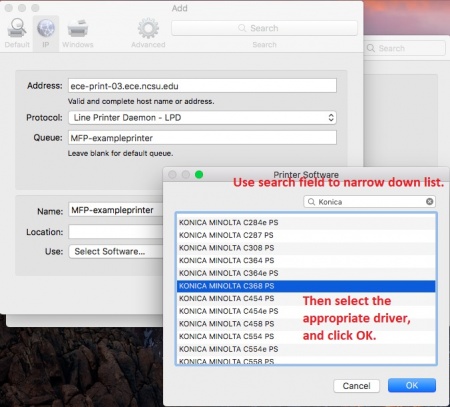Adding printer to OS X
All network printers in the ECE Department can be accessed through our central print server, ECE-PRINT-03. If you have any questions about the print server or experience any problems setting up a printer, please email ecehelp@ncsu.edu.
If you experience issues not covered by these directions or due to version differences, please email us with a description of your problem and which OS version you are using.
Add printers in Mac OS X
STEP 1 - Download and install the appropriate driver
We recommend using a model-specific driver provided by the vendor. The generic drivers may work for older black and white printers, but overall you will have better and more reliable performance with vendor drivers.
Check the manufacturer's website for OS X drivers and be sure to install them before attempting to add the printer.
Again, you must install the driver before adding the printer.
If you cannot locate an appropriate driver or have difficulty installing it, contact us for assistance.
STEP 2 - Opening the Printers & Scanners window
To add printers in OS X, first open System Preferences either from your Dock icon, or from the Apple menu -> System Preferences. From there, choose Printers & Scanners under the Hardware section.
See Figure 1 below. Once in the Printers & Scanners window, click the + button to begin adding a new printer.
STEP 3 - Enter server and printer information
Once the Printer Browser window opens, click on the IP icon at the top. Then fill in the information for the network printer you wish to add.
Address should be "ece-print-03.ece.ncsu.edu", Protocol should remain "LPD", and Queue is the name of the printer (this should be labeled on the printer). Name is how the printer will appear in your printer list, and we recommend again using the printer name. If you do not know the queue name for your printer, please email ecehelp@ncsu.edu.
In Figure 2 below we have used a placeholder name as an example.
STEP 4 - Selecting a specific driver
We recommend using a model-specific driver provided by the vendor. You must have already downloaded and installed the driver before now. If you have not, cancel the add printer wizard and install the driver, then add the printer again.
After you have filled in the server and printer information, click the blue button (with up/down arrows) for the Use field, then click Select Software as shown in Figure 3.
This will bring up the list of installed drivers shown in Figure 4. Use the Search field to narrow the list and select the appropriate driver, then click OK.
Then click Add.
STEP 5 - Options
After adding the printer, OS X will search for installable options such as two sided printing, extra paper trays, etc. You should leave these options as the defaults unless you are certain of options that should be changed or will not be used. Most importantly, you should activate the Duplex or Two-Sided Printing option if you know the printer has that option. Once the options are set, click Continue to finish the process.
Final Notes
You should now to able to print to the printer through your OS X applications.
One last note is that if you need to change any settings for the printer, you may do so by going back into the Print & Fax, choosing the printer in the list, and clicking the "Printer Setup" button. However, you may only change installable options and Name and Location. Changing the print server, print queue, or the driver requires you to remove the printer and re-add it.



